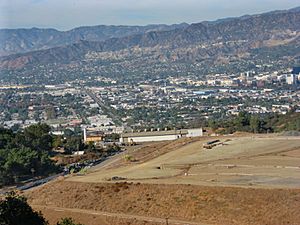Toyon Canyon Landfill facts for kids
The Toyon Canyon Landfill was a large area in Los Angeles' famous Griffith Park where trash was buried. It started taking waste in 1957 and stopped in 1985. People tried to stop the landfill from growing in the 1980s, especially into a nearby area called Royce's Canyon, and they succeeded.
Today, the landfill collects gas that comes from the buried waste. This gas is then used to create electricity! The landfill is managed by the Los Angeles Bureau of Sanitation. They plan to turn the area into a peaceful open meadow for people to enjoy. The landfill officially closed in 2008, meaning it stopped accepting new trash. It will be looked after and checked for at least 30 more years to make sure it's safe. The area is being replanted with local plants like Toyon, Oak, California poppy, and Lupine. Plants that don't belong there, like mustard and tumbleweed, are being removed.
In 2012, new rules for how the landfill handles waste were approved, making sure it stays safe for the environment. You can easily see the landfill from major roads in Los Angeles, like California Routes 2 & 134 and Interstate 5. It's also visible on Google Earth. During a big fire in Griffith Park in 2007, the landfill's helipad was used by helicopters to help fight the flames.
Contents
What is the Toyon Canyon Landfill?
A landfill is a place where garbage is buried. The Toyon Canyon Landfill was built inside Griffith Park, a very well-known park in Los Angeles. It operated for many years, from 1957 to 1985.
Why was the landfill controversial?
When the landfill was first planned, some people were not happy about it. They didn't want a landfill inside a beautiful park like Griffith Park. There was even a legal case in 1959 to try and stop it, but the landfill continued to operate. Later, in the 1980s, there was a plan to make the landfill even bigger and expand it into Royce's Canyon. However, people worked together to stop this expansion, and they won!
How is the landfill managed now?
Even though the landfill is closed, it still needs to be managed carefully. This is because buried trash can produce gas and affect the ground and water.
Turning trash gas into power
One cool thing about the Toyon Canyon Landfill is that it collects the gas that comes from the decomposing (breaking down) waste. This gas, called landfill gas, is then used to generate electricity. This is a way to turn something that could be a problem into a useful energy source.
Monitoring and environmental care
The Los Angeles Bureau of Sanitation is in charge of the landfill. They have a plan to turn the area into a "low intensity open meadow." This means it will be a peaceful, natural space where people can relax. The landfill is checked regularly to make sure it follows environmental rules. It will be monitored for at least 30 years to ensure everything is safe.
Planting native species
To help the area become a natural meadow, workers are planting native plants. These are plants that naturally grow in California, like Toyon, Oak trees, California poppies, and Lupine flowers. At the same time, they are removing plants that are not native, such as mustard and tumbleweed, which can take over and harm the local ecosystem.
Toyon Canyon in movies and TV
Like many places in Los Angeles, Griffith Park and the Toyon Canyon area have been used as filming locations for many movies and TV shows. It's a popular spot for filmmakers!
- Ghost Whisperer (several times)
- E.R. (used to look like Croatia)
- Terminator 3
- Grey's Anatomy (a crash scene)
- Scorpion (2 episodes)
- Mad Men
- Jericho
- Criminal Minds
- The Unit
- Splinter
- The Fast and the Furious
- 2 Fast 2 Furious
- The Fast and the Furious: Tokyo Drift
- Sons of Anarchy
- Many car commercials
- A music video
- Several student films
Facts about the landfill
Here are some interesting facts about the Toyon Canyon Landfill:
- Size: The filled area is about 90 acres.
- Amount of trash: Around 16,000,000 tons of trash were buried here.
- Type of trash: It mainly held Class III waste, which includes household garbage, street sweepings, and construction waste (like old building materials).
- Gas wells: There are about 200 wells that collect gas from the trash.
- Power generation: The landfill uses two special engines to turn the collected gas into electricity.
- Power plant owner: Montauk Energy owns the power plant.
- Power plant operator: SCS Engineers operates the power plant.


